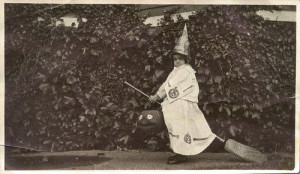Recycling Gets Spooky
Halloween, All Hallow's Eve, Samhain - whatever you may call the 31st day of October, the traditions of both tricks (and treats) enchant imaginations around the world on this haunted evening.
To add to the array of creepy costumes, ominous decor and an unearthly consumption of sweet treats, we think it only fitting to provide some spine-chilling facts and tips about the wicked fun of going green on All Hallow's Eve... and beyond.
A Harrowing Halloween
Ghosts and goblins won't be the only things giving you nightmares:

Historians date the modern take on Halloween back to the mid-1800s, when Irish immigrants brought the tradition to the U.S. during the Great Famine. Photo: Flickr/stevechasmar
- 1.1 billion pounds of pumpkins were produced in 2008 by major pumpkin-producing states such as Illinois, California, Pennsylvania and New York. Many are used each fall for jack-o'-lanterns and pumpkin pies. Once Halloween is over, you can reuse or recycle your pumpkin.
- A 2008 National Retail Foundation survey found that 64.5 percent of people celebrate Halloween in some way. That's a higher number than the individual recycling rates of aluminum, glass, paper and plastic bottles.
- Each Halloween, an estimated $40 per capita is spent on candy, decorations and greeting cards, all of which produce large amounts of waste.
- Leaves can account for 75 percent of the solid waste stream in the fall.
- Americans consumed 23.8 pounds of candy per capita in 2008. Most of the wrappers are made of mixed materials, making it difficult to recycle them.
- An estimated 80,000,000 Hershey's Kisses are wrapped each day, using enough aluminum foil to cover more than 50 acres of space, the equivalent of almost 40 football fields.
- The U.S. spends almost $4 billion annually on electricity lost to "vampire power," according to the International Energy Agency. Vampire power, also known as "phantom load," is the electricity that electronics and appliances use while they are turned off or in standby mode.
(See more about this video and experience augmented reality at VampirePowerSucks)
Frightening Recycling
The results from skipping out on this simple step are simply spine-tingling:
- Each ton of recycled paper can save 17 trees, 380 gallons of oil, three cubic yards of landfill space, 4,000 kilowatts of energy and 7,000 gallons of water. This represents a 64 percent energy savings, a 58 percent water savings and 60 pounds less of air pollution.
- In 2007, we generated 3.01 million tons of e‐waste in the U.S. Of this amount, only 410,000 tons (or 13.6 percent) was recycled, according to the EPA. The rest was sent to landfills or incinerators.
- To produce each week's Sunday newspapers, 500,000 trees must be cut down. Recycling a single run of the Sunday New York Times would save 75,000 trees. If all our newspaper was recycled, we could save about 250,000,000 trees each year.
- Americans use 2,500,000 plastic bottles every hour. Most of them are thrown away.
- Recycling just one ton of aluminum cans conserves the equivalent of 36 barrels of oil, or 1,665 gallons of gasoline.
- The EPA estimates that 75 percent of our waste is recyclable. However, the current national is about 33 percent. The difference? Scary.

According to tradition, pumpkins are carved to ward off evil spirits. Photo: Flickr/WxMom
Creepy Crawly Conservation
The eerie effects of waste:
- A modern glass bottle would take 4,000 years or more to decompose. That number is even higher if it's in a landfill.
- Every year, each American throws out about 1,200 pounds of organic garbage that can be composted.
- Since 1990, the total amount of municipal solid waste going to landfills dropped by about 5 million tons from 142.3 million to 137.2 million tons in 2007.
- Every year, Americans produce enough polystyrene cups to circle the earth 436 times.
- Americans throw away enough disposable plates and cups to give the world a picnic six times a year.
- If the U.S. cut office paper use by just 10 percent, it would prevent the emission of 1.6 million tons of greenhouse gases - the equivalent of taking 280,000 cars off the road.
- Americans' total yearly waste would fill a convoy of garbage trucks long enough to wrap around the earth six times or reach halfway to the moon.
So what's the take-home message? When you're roaming the dark streets on Halloween, don't forget your garlic, flashlight and your eco-smarts. Even though the ghoulish evening is cause for celebration the world over, there's nothing more bone-chilling than leaving your green out of the festivities on this day and throughout the rest of the year.
Jennifer Berry contributed to this article.

Lauren Hasler
Lauren is a journalism major at the University of Missouri with an interest in environmental sustainability education.

Comments(0)